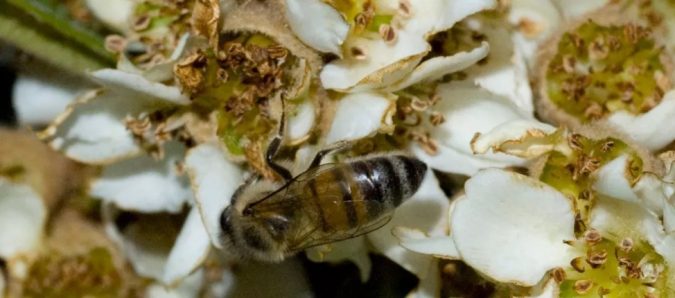| Family | Rosaceae |
| Genus | Eriobotrya |
| Species | E. japonica |
| Common names | loquat, pipa, Japanese medlar, Japanese plum, Chinese plum, nespola |
| ZBAS*: | 6 |
Loquat is a fruit tree native to China, but I have seen it in Louisiana, Florida, Brazil and Mexico, so probably introduced to everywhere. It has a sweet taste, some varieties more sour than others. The large seeds inside the fruit and young leaves are slightly poisonous. This is due to cyanogenic glycosides (including amygdalin) which release cyanide when digested. Loquat is used commonly in cough syrup in China, so I wonder if the honey from this plant will have similar medicinal qualities.
It is a strange plant in that it flowers around Dec (Nov to Jan) in south China. In my home town Hunan, during Nov/Dec it will be 10-13 degrees C, so only the Asian honey bee Apis cerana will be mostly foraging on this flower, because A. mellifera will need about 15/16 C to forage.
1. My first photos of bees on loquat flowers were on Jan 8, 2008, Baton Rouge, Louisianna. It should be close to Prof. Fangneng Huang’s house where he hosted me during a seminar. They looked like African bees to me. 
2. A bee buried deeply to reach nectar. 
3. Two bees trying…
4. This bee looked similar to our bees here in Michigan. 
5. This bee seems to be more African like, it is hard for me to describe. A bit smaller, slightly different coloration. 
6. This was shot near a famous pavilion (Yueyang Pavilion) in Yueyang, Hunan. They are all Apis cerana. Nov 16, 2008. I tried to find some good photos, but none. I checked the time frame, I spent 3 minutes, vs the 17 min for the photos of 1-4 above. So, good photos take time.

7. Can you see the different coloration of this bee (compared to A. mellifera)? No pollen on her.

8. This one seems to have more nectar.

9. Also A. cerana foraging on loquat, Nov. 23, 2008. Shot at Qiandao Lake, a honey bee research base of Prof. Cheng, who works at the Zhejiang University. It seems I spent more time shooting bees.
10. None of the bees were seeing collecting pollen. 
11. Another shot. 

